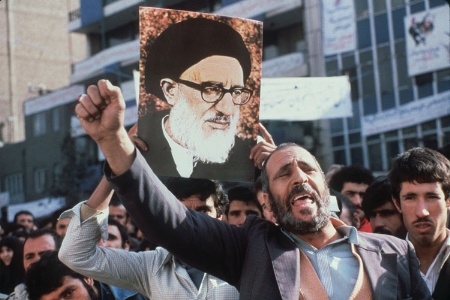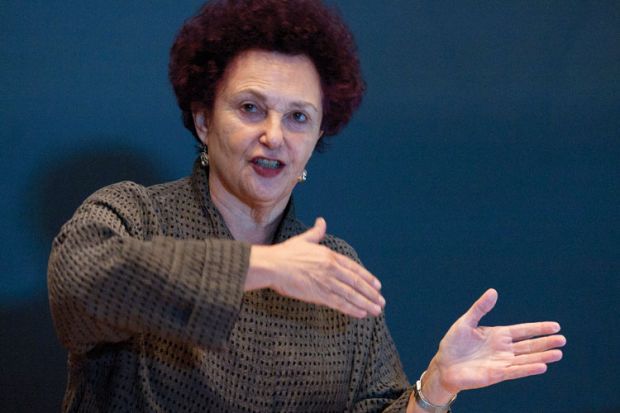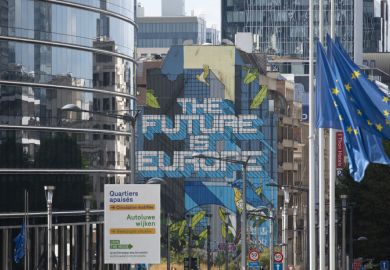‘Persona non grata’: Annabelle Sreberny fears research restrictions may mean ‘missing out on a whole generation of social and cultural research on Iran’
When it came to researching Iran, Annabelle Sreberny started off with a ringside seat.
She was doing postgraduate work in sociology at Columbia University in New York and contemplating an “eminently forgettable” PhD on a topic such as “Habermas and the public sphere”. While in the US, however, she had begun a relationship with an Iranian fellow student. After marrying in the UK, they moved to Tehran in 1976, where Sreberny secured teaching work at the National University of Iran, an all-women’s college and a college run by National Iranian Radio and Television as part of its training.
This was the tail end of the Shah’s reign and, Sreberny recalls, “it quickly became obvious that some things were bubbling up…Watching people in a repressive regime beginning to mobilise politically was fascinating”.
Although an expert in neither communications nor Iranian politics, Sreberny soon decided that she wanted to study these “serious beginnings of social ferment” and what she was hearing from her students in small discussion groups and on mass demonstrations.
This became the focus of her PhD, eventually published as Small Media, Big Revolution: Communications, Culture and the Iranian Revolution (with Ali Mohammadi) in 1994.
The key sources were two kinds of “small media”. The first of these were the cassettes recorded in France by the then exiled Ayatollah Khomeini “critiquing the political and social environment of the Pahlavi regime”.
Equally interesting were “a whole range of cyclostyled and xeroxed pamphlets and leaflets responding to unfolding events, which would turn up in classrooms or under windscreen wipers”.
Only someone based in Iran could possibly have had access to this material, and it gave Sreberny crucial insights into how “revolutions have to be seen as communicative processes as well as simply political movements”.
This international perspective proved crucial to her subsequent career. She was employed at Queens College (part of the City University of New York) and the University of Leicester before being appointed the first professor of global media and communications at Soas, University of London in 2003.
Curfews, tanks and gunfire
Iran remains a major strand of Sreberny’s research. She played a central role in establishing Soas’ Centre for Iranian Studies and one of the country’s first stand-alone MAs on the subject. She has co-written two further books, Blogistan: The Internet and Politics in Iran (with Gholam Khiabany, 2010) and Persian Service: The BBC and British Interests in Iran (with Massoumeh Torfeh, 2014), and co-edited the collection Cultural Revolution in Iran: Contemporary Popular Culture in the Islamic Republic (also with Massoumeh Torfeh, 2013). Yet none of these works could draw on the kind of “participant observer” status that she brought to her doctorate and her first book.
To understand why, we must return to the late 1970s. Although she had her first child in the UK (because “I didn’t think I could give birth properly in Persian”), Sreberny took her daughter back in 1978 to the chaos of the Shah’s collapsing regime: “As the mobilisation escalated, a military curfew was imposed – people couldn’t be out on the streets after 9pm – and it became difficult to fly in and out of Iran.

“You pushed the buggy past a tank with soldiers. It was a very tense period, when you could hear the sound of gunfire and slogans being shouted in phone calls from other parts of the city.”
If this was worrying, the atmosphere after the Shah left and Khomeini returned to set up an Islamic republic in early 1979 was even less comfortable. Sreberny remembers restrictions on “women’s rights and the media; disruptions in everyday life, such as shortages of toothpaste and chicken; a clampdown and then shutdown of the universities”.
A strong climate of anti-Westernism added to the volatile mix. The family therefore decided to leave Iran in 1980.
Although Sreberny did not return for nine years, she has since visited the country a few more times on family visits, to attend conferences and occasionally to deliver papers. The last occasion was at the end of 2008, when BBC Persian Television was scheduled to start, so she “wanted to be there to hear the buzz, hear what Iranians thought about this new television station coming from Britain”.
In the event, the launch was delayed, but she was still able to “conduct quite a lot of interviews around Iran’s position in the international media environment – what was happening in terms of cultural policy”.
She also had an opportunity to revisit the radio and television station where she had worked, now renamed Voice and Vision of the Islamic Republic, and “had a fascinating lunch with one of the [country’s] key ideologues, where we ended up arguing about whether [former chief justice] Ayatollah Beheshti or Freud understood human nature and sexuality better”.
The always difficult post-1979 cultural and academic environment in Iran became particularly bad under President Mahmoud Ahmadinejad (in power from 2005 to 2013), when more than 70 subjects were closed to women. Foreign scholars still need to go through the laborious and intrusive process of acquiring a research visa. And Sreberny herself has been “told by other people that I should be careful…I am told I am persona non grata, my name has come up – and Soas has come up as a place that is being monitored”.
In researching the BBC Persian Service, for example, she was able to track the often tense relations between the corporation, the Iranian government and the Foreign Office but was unable to ask ordinary Iranians what they think about the programming. As other researchers face similar restrictions, she fears that we run the risk of “missing out on a whole generation of social and cultural research on Iran”.
“If you work on policy, you want to talk to policymakers. If you work on media, you want to talk to producers. If you work on social media, you want to talk to activists. You can’t do that. So you end up doing a lot of textual analysis, but you can’t get the smell or feel of the place.”
Despite the intense interest in a country often close to the top of the news agenda, it may be a long time before outside scholars can again draw on the kind of first-hand insights that Sreberny was able to make her own in the 1970s.
Register to continue
Why register?
- Registration is free and only takes a moment
- Once registered, you can read 3 articles a month
- Sign up for our newsletter
Subscribe
Or subscribe for unlimited access to:
- Unlimited access to news, views, insights & reviews
- Digital editions
- Digital access to THE’s university and college rankings analysis
Already registered or a current subscriber? Login





